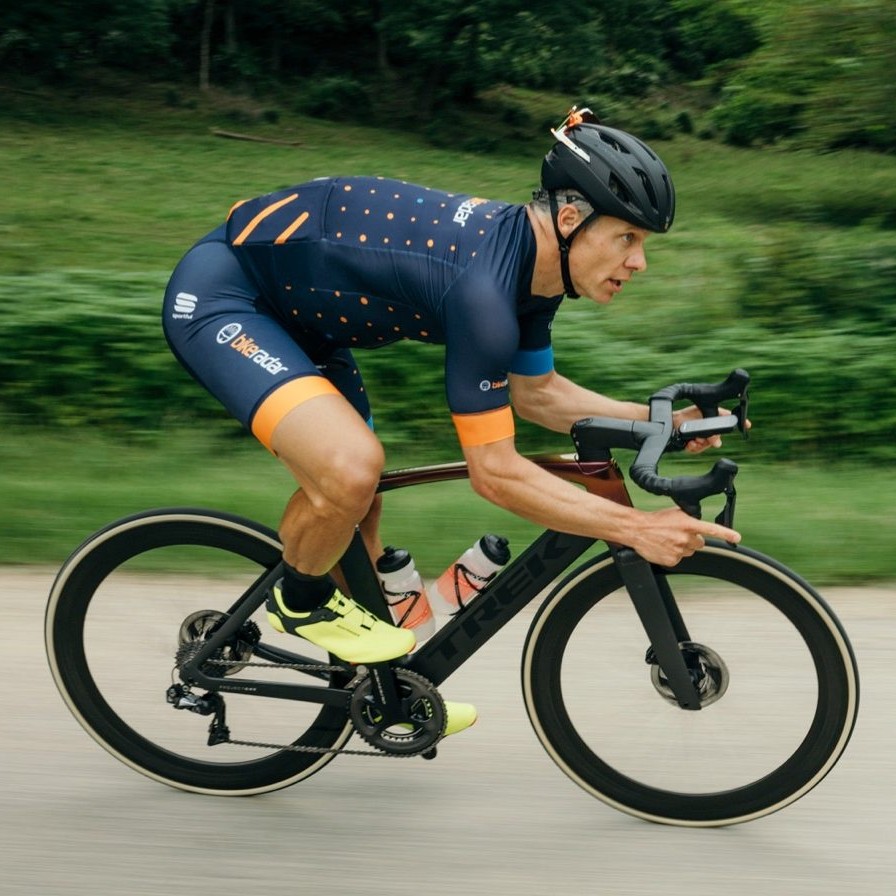The cobbled classics, the Tour of Flanders and Paris-Roubaix, present unique challenges to professional riders, and teams adopt a variety of gear solutions for the two races in early April. Trek's solution, though not inexpensive, is straight-forward: two completely different versions of the Domane endurance bike for each.
Although Flanders has many cobbled sections, it is regarded as less harsh than Paris-Roubaix, and this year we saw standard race bikes and even aero bikes there, often with slightly wider tubulars to take the edge off. Other riders opted for endurance bikes at Flanders, sometimes with steeply angled stems to achieve their preferred low positions. At Paris-Roubaix, however, teams pull out all the stops to soften the beating the rough stones dish out.
Stijn Devolder, like his teammates, had a Trek Domane Koppenberg for Flanders, which featured straight-ahead race geometry as on the Trek Emonda climbing bike, but built into the bump-absorbing chassis of the Domane, with its IsoSpeed Decoupler that allows for significant seat tube flex. Unlike the standard Trek Domane, the wheelbase is tight, the head tube low and the angles steep.
"Compliance is still beneficial for Flanders, but the geometry for Flanders is very nimble," said Trek team liaison Jordan Roessingh. "The Tour of Flanders requires a lot more handling of the bike, with the narrow, twisty roads with tight corners."
For Paris-Roubaix, Devolder will ride his Trek Domane Classics, which has a low head tube like an Emonda, but with a longer wheelbase, a slacker head angle, and a lower bottom bracket. The configuration there is all about stability.
Devolder's fit coordinates are identical between the two machines.

Both Domane machines share this IsoSpeed Decoupler, but vary greatly in handling characteristics
"You see all these teams, even different riders within the same team, coming up with different strategies for tweaking their Paris-Roubaix bikes for Flanders," Roessingh said. "You see a climbing bike or an aero bike with bigger tires trying to make up for compliance. We tend to run smaller diameter tires than everyone else because the frame adds compliance."
Indeed Trek was one of the few teams at the Tour of Flanders with 25mm tubulars across the board, and the team will only use 27mm tubulars for Paris-Roubaix, where others are going with 28 and even 30mm options.
The Bontrager wheels on the Domane bikes are different than standard Aelous models. The Aelous 5 Classic has the same shape as the regular rim but it's designed to fit a wider tubular, which Roessingh says makes for a better connection with the tubular and also allows for more compression and suspension of the tire. It is laced the same as the standard Aeolus 5.
The easiest way to differentiate the Domane Classics from the Domane Koppenberg is the fork. The Domane Classics has a 53mm rake fork while the Domane Koppenberg has a 40mm rake — achieved by using the same mold but with aluminum caps that kick sharply back to lessen rake. The trail between the two is pretty similar, as the Classics has a slack head tube.
The Domane Classics also sits 1cm closer to the ground at the bottom bracket - and therefore Devolder's saddle and handlebars are also 1cm lower.
Complete bike specifications
- Framesets: Trek Domane Classics, Trek Domane Koppenberg
- Stem: Bontrager XXX, 12cm, 7 degree
- Handlebar: Bontrager RL VR, 42cm
- Front brake: Shimano Dura-Ace 9000
- Rear brake: Shimano Dura-Ace 9000
- Front derailleur: Shimano Dura-Ace Di2
- Rear derailleur: Shimano Dura-Ace Di2
- Shift levers: Shimano Dura-Ace Di2
- Cassette: Shimano Dura-Ace, 11-25t on Classics, 11-28t on Koppenberg
- Chain: Shimano Dura-Ace
- Crankset: Shimano Dura-Ace 9000, 172.5mm, 53/44t on Classics, 53/39t on Koppenberg
- Pedals: Shimano Dura-Ace
- Front wheel: Bontrager Aelous Classics
- Read wheel: Bontrager Aelous Classics
- Front tubular: FMB Paris-Roubaix, 25mm on Classics, 27mm on Koppenberg
- Rear tubular: FMB Paris-Roubaix, 25mm on Classics, 27mm on Koppenberg
- Saddle: Bontrager Serano RL 148
- Bottle cages: Bontrager (2)
Critical measurements
- Rider's height: 182cm (6ft)
- Rider's weight: 72kg (159lb)
- Frame size: 58cm H1
- Saddle height from BB, c-t: 79.1cm
- Tip of saddle to center of bar: 56.2cm
- Saddle-to-bar drop: 12cm
- Saddle setback: 6.7cm





























